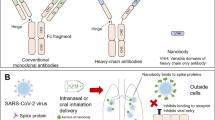Summary
The results obtained with two drugs that were found to be effective against influenza virus infection in mice are reported.
The two drugs are C. V. 57455 (4-biphenylylglyoxal bisulfite) and C. V. 58903 (α-oxo-α-(4-biphenylyl)-β-ethoxy-β-(4-carboxy-phenyl) amineethane).
The drugs were active after administration by the subcutaneous, the oral or the nasal routes prior to and partly also 24 hours after, but not 48 hours after instillation of 5 LD50 of the virus.
The drugs were active in low doses providing for an ample margin between the toxic and effective range.
The hemagglutinin titers of the lungs of mice which died despite treatment were lower than those found in the lungs of untreated mice.
The hemagglutinin titers of the lungs of surviving, unaffected, drugtreated mice were very low or undetectable.
The surviving drug-treated mice were resistant to reinfection 2 to 6 weeks later.
Similar content being viewed by others
References
Buu-Hoï, N. P., A. Bouffanais, P. Gley, N. B. Xuong, etN. H. Nam: Activité in vivo de dérivés de la thiourée contre le virus de l'influenza. Experientia12, 73–75 (1956).
Bock, de C. A., J. Brug, andJ. N. Walop: Antiviral Activity of Glyoxals. Nature179, 706–707 (1957).
Hurst, E. W.: Approaches to the Chemotherapy of virus Diseases. J. Pharm. and Pharmacol.9, 273–292 (1957).
Lindemann, J., D. C. Burke, andA. Isaacs: Studies on the production, mode of action and properties of interferon. Brit. J. Exp. Path.38, 551–562 (1957).
Liu, O. C., R. G. Malsberger, J. E. Carter, A. N. De Sanctis, F. P. Wiener, andB. Hamph: Studies on the chemotherapy of viral infections. J. of Immunology78, 214–227 (1957).
Lum, G. S. andP. K. Smith: Experimental Chemotherapy of Influenza Virus with Particular Reference to Thiosemicarbazones and Diphenyl Compounds. J. of Pharm. Exp. Ther.119, 284–293 (1957).
Moffett, R. N., B. D. Tiffany, B. D. Aspergren, andR. V. Heinzelman: Antiviral Compounds. II. Aromatic Glyoxals. J.A.C.S.79, 1687–1690 (1957).
Tiffany, B. D., J. B. Wright, R. B. Moffett, R. V. Heinzelman, R. E. Strube, B. D. Aspergren, E. H. Lincoln, andJ. L. White: Antiviral Compounds. I. Aliphatic Glyoxals, α-Hydroxyaldehydes and Related Compounds. J.A.C.S.79, 1682–1687 (1957).
Author information
Authors and Affiliations
Additional information
The results were communicated in part to the “Accademia Nazionale dei XL”, Rome-Italy.
Rights and permissions
About this article
Cite this article
Magrassi, F., Cavallini, G. & Massarani, E. Drugs active against influenza virus infection in mice. Archiv f Virusforschung 10, 19–30 (1961). https://doi.org/10.1007/BF01258765
Received:
Issue Date:
DOI: https://doi.org/10.1007/BF01258765




